Modelling Fuzzy Logic Type-2 for Liquid Waste Control of Aerator Machine
on
Journal of Electrical, Electronics and Informatics, p-ISSN: 2549–8304 e-ISSN: 2622–0393
6
Modelling Fuzzy Logic Type-2 for Liquid Waste
Control of Aerator Machine
I Made Mataram 1, I Ketut Wijaya 2
1Department of Electrical Engineering, Engineering Faculty Udayana University, Kampus Bukit Jimbaran Badung-Bali, Indonesia 80361 mademataram@unud.ac.id
2Department of Electrical Engineering, Engineering Faculty Udayana University, Kampus Bukit Jimbaran Badung-Bali, Indonesia 80361 wijaya@ee.unud.ac.id
Abstract Waste water cannot be disposed of directly, so it must be processed so as not to cause pollution to the surrounding environment. Both BOD (Biological Oxygen Demand) and COD (Chemical Oxygen Demand) treatment, oxygen is also required so that the quality of the liquid waste is safe for the environment. Waste water treatment mostly utilizes aerators to produce high pressure air in liquid waste containing oxygen (O2). The problem that occurs in most waste water treatment is the determination of the working time of the aerator machine, resulting in excessive use of electrical energy, but the results of the waste are still within unsafe limits. In general, the operating time of the aerator is manually, this causes the use of electrical energy to be wasteful. This research was conducted, how to develop a control system design for aerator operating time on the quality of liquid waste. The development of the control system used is Sugeno interval fuzzy logic type-2 with 2 (two) input types of Gauss membership function. The advantage of interval fuzzy logic type-2 over type-1 fuzzy logic is the ability to provide more accurate output for higher input uncertainty. The input variables used are waste volume and COD reduction, while the output is the aerator's operating time. The advantages obtained in the system design can be applied properly and in accordance with the setting point with an average aerator operating time of 6.8 hours and can reduce the use of electrical energy by 38.2%.
Index Terms— Aerator operating time, COD reduction, Energy consumption, Interval Fuzzy Logic type-2.
-
I. INTRODUCTION1
The wastewater treatment plant model that is often encountered is biologically activated sludge (Activated Sludge Unit) which is a bioreactor (aeration tank) called an aerated lagoon. The mechanism for the growth of microorganisms requires oxygen (O2) in the form of air (gas phase) directly to the liquid phase through stirring. In general, oxygen is produced by an aerator by the aeration process as a producer of oxygen in the form of air foam mixed with water to reduce BOD and COD aerobically. Based on preliminary research data, the Suwung WWTP aerator is still operated manually for 11 hours per day. Uncertain aerator operation causes the use of electrical energy to be wasteful. Based on the description above, this study aims to design and make an automatic control device
in an intelligent way with the output of aerator working time (hours) and input of liquid waste characteristics based on interval fuzzy logic type-2 but the waste output is still within safe limits.
Modern control technology using a different treatment aeration control system strategy shows, electrical energy consumption to be reduced by about 30%. [1,2]. Methods with fuzzy logic techniques can be applied by utilizing the advantages of linguistic reasoning processes without the need for complicated mathematical models. The development of technology as a classical control strategy that has complex nonlinear process constraints with the help of simulation models has proven to be a tool for researchers to evaluate algorithms [3,4].
Research on industrial wastewater treatment with aeration process shows that the maximum bacterial growth occurs with an aeration time of 8 hours and the effectiveness of the aeration system in liquid waste shows that aerators can reduce COD and suspended solids in
liquid waste. [5,6].
A regulatory expert system based on fuzzy logic rules was developed by Alper KAYA and Doaa M. Atia for the diagnosis and control of a wastewater treatment plant. proportional integrative derivative (PID), turned out to be the easiest and most effective method accepted as the fuzzy logic control method[7,8].
Research conducted by Lisa Harrington, et al., on controlling aeration on-off at intervals of 3 hours can reduce BOD, increase pH, maintain nitrite levels and can maintain bacterial growth wastewater [9].
Research on the application of PI control on aerators shows that regulating the rotational speed of the motor on a wastewater treatment aerator can be adjusted to the oxygen level, so that the oxygen requirement to decompose pollutants in the waste can be adjusted [10].
-
II. RESEARCH METHOD
The research data were taken from the daily wastewater treatment plant (WWTP) for 3 months. The data collected in this study are in the form of standard data on liquid waste quality, daily BOD&COD data, volume of liquid waste, number of waste aerators, aerator specifications, data on the length of time (hours) of aerator work and data on daily electricity consumption (KWh) of aerators.
-
A. Design Model of Interval Fuzzy Logic (ILF type-2
The software design for this system can be explained as follows. The design for the fuzzy logic control system (FIS) uses two inputs and one output with the Sugeno inference model. The input used is the volume value and COD reduction, while the output used is the aerator operating time. Both inputs have three quantization types of Gaussian member functions, while the output uses nine membership functions with constant types. The number of basic rules (Rule base) consists of 9 (Nine) rules, as shown in Figure 1.
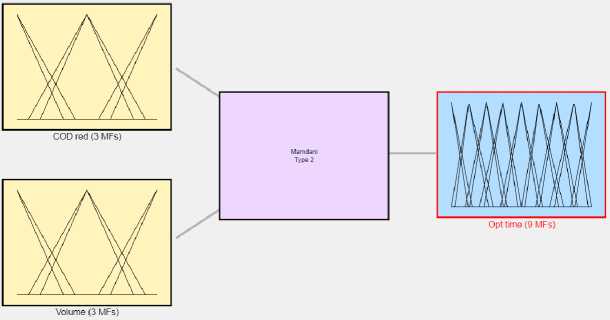
Fig. 1. ILF type-2 Design
The first input variable is volume use three quantization, namely negative (a little), zero (normal) and positive (a lot), as shown in Figure 2.
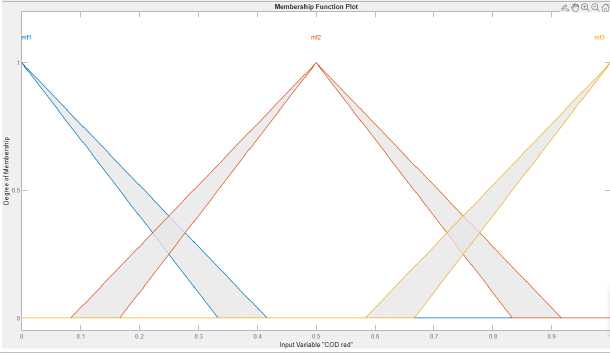
Fig. 2. COD Reduction Input of ILF type-2
The second input variable is COD reduction using three quantization are negative (small), zero (medium), positive (large), types of Gaussian membership function as shown in Figure 3.
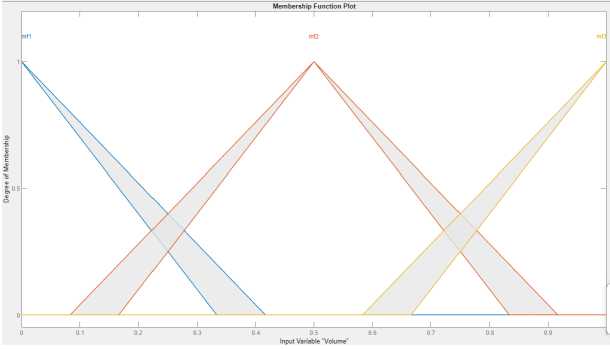
Fig. 3. Volume Input of ILF type-2
The output is the aerator operating time using 9 (nine) constant types of quantization, namely mf1, mf2, mf3, mf4, mf5, mf6, mf7, mf8, and mf9 as shown in Figure 4 below.
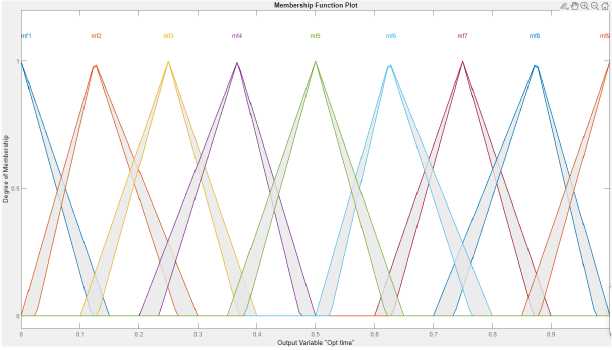
Fig. 4. Output Operation Time of ILF type-2
The system inference process using the Sugeno model contains 9 (nine) membership functions mf1, mf2, mf3, mf4, mf5, mf6, mf7, mf8, and mf9, the basic rules used are as follows.
-
1. If (Volume is Negative AND CODred is Negative ) THEN (operation time is mf1)
-
2. If (Volume is Negative AND CODred is Zero) THEN (operation time is mf2)
-
3. If (Volume is Negative AND CODred is Positive) THEN (operation time is mf3)
-
4. If (Volume is Zero AND CODred is Negative) THEN (operation time is mf4)
-
5. If (Volume is Zero AND CODred is Zero) THEN (operation time is mf5)
-
6. If (Volume is Zero AND CODred is Positive ) THEN (operation time is mf6)
-
7. If (Volume is Positive AND CODred is Negative) THEN (operation time is mf7)
-
8. If (Volume is Positive AND CODred is Zero) THEN (operation time is mf8)
-
9. If (Volume is Positive AND CODred is Positive) THEN (operation time is mf9)
Based on the type-2 ITF design above, the basic rules look like Figure 5 below.
|
Fuzzy IfanceSystem (FIS)Plel Membership Function(MF)Editor RuIeEdto |
line |
Optine | |||||
|
Systat β⅛i⅛2 |
— | ||||||
|
Range |
(O | ||||||
|
AddAliposstIeRuIts ∣ Clw All Rules |
NunberofllFs: S | ||||||
|
Rule |
Rae |
W |
Upper |
Loner |
Loner | ||
|
1 |
IiccDredisfiflaadwiuBisnftaCpticescf" |
Parameters |
Scale |
Laj | |||
|
S |
If CCD red IsmO and Wub IsmflttaOpt line is if |
mfl |
TriatJU... |
μ,≡mii: |
IW W | ||
|
3 |
IfcoDfedismBaiwiBismfltaOptIineisntS |
mO |
TriatJU... |
lll.1i50.3l |
IiME | ||
|
I |
Il CCD fed is mfl ad Wib IsmIitaOptife s mN |
ι∣β |
Triatju... |
[0.10.250.4] |
MiE | ||
|
5 |
IfccDredisnoaiidwiiiBisnEtaCptitesiili |
mfl |
TriatJU... |
IBWiliI |
IiEiEI | ||
|
6 |
If CCD red is ∏B aid Wib is mE ta Cpt line s U |
ml! |
Triatju... |
∣iiil)≡∣ |
MiEI | ||
|
IfccDredisfiflaiidWiBismBtaOptIine s if |
Ilfi |
TiiaiiJU... |
[0,50.6250,3∣ |
∣ME | |||
|
I |
IfccDredisnoaiidwiiiBisnBtaCptitesiifi |
Ilfi |
TriatJU... |
∣m≡!∣ |
MiEI | ||
|
! |
IfccDredisnBaidwiuBisnBtaCptitestfi |
mfl |
Triatju... |
∣07 0.8751] |
MiEI | ||
|
IifS |
Triaiiju... |
IlItSIIlI |
IiEiEI | ||||
Fig. 5. Rules base of ILF type-2
-
B. Inference system Process
The inferential process of the system consists of antecedent processes, consequent processes and aggregations. The final output value is obtained after going through the reduction process using the Karnik-Mendel (KM) method.
-
III. RESULTS AND DISCUSS
Based on the proposed type-2 fuzzy logic interval design, testing using real data for 30 (thirty) days. The simulation results can be seen in table 1.
the smallest energy consumption value of 968.4 KWh and the largest 1156.0 KWh. Total energy consumption per month is 33,630 KWh, while based on real data, electricity consumption is 54,450 KWh. This means that there is a decrease in electricity consumption per month by 38.2%. This is also supported by research conducted by Amand L, et al and Filali A et al [1],[2].
The type-2 fuzzy ITL control design uses volume input and COD reduction with the output of the aerator operating time and 8 basic rules to produce a Surface view graph as shown in Figure 6. The average aerator operating time is almost the same for the volume and COD reduction is small to moderate. While the operating time of the aerator shows an increase for large to very large COD reductions.
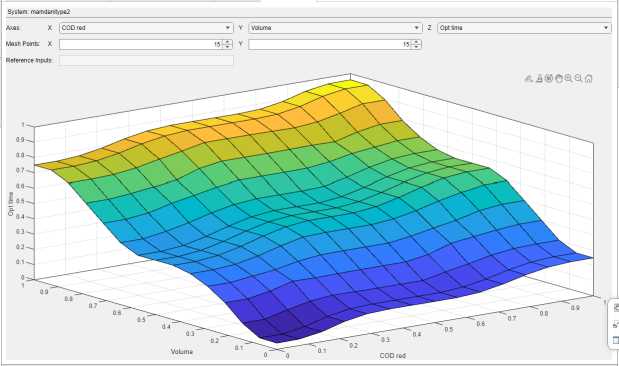
Fig. 6. Rules View of ILF type-2
-
IV. CONCLUSION
The advantages of ITL fuzzy type-2 aerator control modelling have been well used for setting the working time of the aerator in waste water treatment and the calculation process to obtain a relative output does not require a high level of mathematics. In this study, the proposed control model is able to reduce the use of electrical energy by 38.2% with an average aerator operating time of 6.8 hours, this means that it automatically reduces the cost of monthly electricity payments. For further research, it can be developed and the performance of the system can be compared with conventional control methods and other intelligent controls.
Based on table 1, it can be calculated that the average volume is 14891.1 m3, with the smallest value of 8146.8 m3 and the largest of 53893.5 m3. The average COD reduction was 27.37%, with the smallest value of 0% and the largest being 130%, while the average length of operation of the aerator was 6.79 hours, with the smallest value of 5.87 hours and the largest value of 7.01 hours. The average energy consumption per day is 1121.0 KWh, with
ACKNOWLEDEGMENT
Thank you to LPPM Udayana University for the financial assistance for the 2021 Udayana Leading Research scheme.
TABLE 1
OUT UT RESULTS OF AERATOR O ERATION AND ENERGY CONSUM TION
|
Parameter |
Unit |
Results | |||||||||
|
1 |
2 |
3 |
4 |
5 |
6 |
7 |
8 |
9 |
10 | ||
|
Volume_1 |
m3 |
8769.9 |
10657.8 |
11197.2 |
15596.1 |
16237.8 |
17418.9 |
53893.5 |
8332.8 |
8825.7 |
9141.9 |
|
Volume-2 |
m3 |
9262.8 |
9327.0 |
9588.3 |
10704.3 |
13150.2 |
13168.8 |
16581.9 |
25816.8 |
44035.5 |
8146.8 |
|
Volume_3 |
m3 |
8900.1 |
9774.3 |
10397.4 |
11355.3 |
11885.4 |
9588.3 |
19092.9 |
24924.0 |
9718.5 |
11243.7 |
|
CODred_1 |
percen |
52 |
20 |
30 |
14 |
8 |
0 |
48 |
14 |
30 |
4 |
|
CODred_2 |
percen |
0 |
12 |
32 |
18 |
8 |
30 |
24 |
24 |
4 |
6 |
|
CODred_3 |
percen |
30 |
32 |
80 |
32 |
33 |
32 |
12 |
130 |
36 |
26 |
|
Opt time_1 |
h |
6.11 |
6.98 |
6.89 |
6.97 |
6.98 |
6.97 |
6.58 |
7.00 |
6.90 |
7.00 |
|
Opt time _2 |
h |
6.99 |
6.85 |
6.98 |
6.89 |
6.99 |
6.89 |
6.95 |
6.84 |
6.19 |
7.01 |
|
Opt time _3 |
h |
6.89 |
6.85 |
5.87 |
6.86 |
6.83 |
6.85 |
6.95 |
5.89 |
6.73 |
6.94 |
|
Energy_1 |
KWh |
1008.8 |
1152.4 |
1137.9 |
1151.1 |
1151.1 |
1151.0 |
1150.1 |
1086.0 |
1155.3 |
1138.0 |
|
Energy_2 |
KWh |
1155.5 |
1155.0 |
1131.0 |
1153.2 |
1153.2 |
1137.6 |
1146.2 |
1130.0 |
1023.0 |
1156.0 |
|
Energy_3 |
KWh |
1138.0 |
1131.0 |
968.4 |
1131.1 |
1126.9 |
1131.0 |
1147.9 |
971.9 |
1110.6 |
1146.4 |
|
Volume average = 14891.1 |
CODred |
average = 27.37 Operation time |
average= |
6.793939082 |
Energy average = |
1121.0 | |||||
REFERENCES
-
[1] Amand, L. & Carlsson, B. 2013. Optimal aeration control in a nitrifying activated sludge process. Water Research 46 (7 , 2101– 2110.
-
[2] Filali, A. Fayolle, Y. Peu P.. Philippe L, Nauleau F., et al.2014. Aeration control in a full-scale activated sludge wastewater treatment plant: impact onperformances, energy consumption and N2O emission. ICA2013 [00941253]
-
[3] Amand, L. Olsson, G. dan Carlsson,B. 2013. Aeration control – a review. Water Science & Technology , 67.11
-
[4] Nurroisah, E. Indarjo,S. Wahyuningsih,A.S. 2014. Keefektifan Aerasi Sistem Tray dan Filtrasi sebagai Penurunan Chemical Oxygen Demand an Padatan Tersuspensi pada limbah cair. Unnes Journal of Public Health.
-
[5] Wagini,R. Karyono. Budi, A.S. 2002. Pengolahan Limbah Cair Industri Susu. Manusia dan Lingkungan vol 9 hal 23-31.
-
[6] Tirtowiyadi,B.H. 2014. Aplikasi Kontrol Proportional Plus Integral Pada Pengaturan Kadar Oksigen (Dissolved Oxygen Akuarium. Tugas Akhir Jurusan Teknik Elektro Fakultas Teknik Universitas Diponegoro
-
[7] Doaa M. Atia1, Faten H. Fahmy1, Ninet M. Ahmed1, dan Hassen T. Dorrah2. 2012. Design and Control Strategy of Diffused Air Aeration System. The Online Journal on Power and Energy Engineering OJPEE
-
[8] KAYA, A. 2006. Fuzzy design of wastewater treatment plants. Graduate Scool of Natural and Aplied Science
-
[9] Harrington, L. Kaemmerling,C. and Leininger, J.2014. On/Off Aeration Control of an Activated Sludge Digestion System. ENV-4970 Environmental Field.
-
[10] Timoty J. Ross. 1995. Fuzzy Logic With Engineering Applications.
McGraw-Hill, Inc.
Discussion and feedback